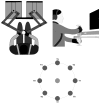Inter-limb interference during bimanual adaptation to dynamic environments
- PMID: 20174919
- PMCID: PMC4505836
- DOI: 10.1007/s00221-010-2175-9
Inter-limb interference during bimanual adaptation to dynamic environments
Abstract
Skillful manipulation of objects often requires the spatio-temporal coordination of both hands and, at the same time, the compensation of environmental forces. In bimanual coordination, movements of the two hands may be coupled because each hand needs to compensate the forces generated by the other hand or by an object operated by both hands (dynamic coupling), or because the two hands share the same workspace (spatial coupling). We examined how spatial coupling influences bimanual coordination, by looking at the adaptation of velocity-dependent force fields during a task in which the two hands simultaneously perform center-out reaching movements with the same initial position and the same targets, equally spaced on a circle. Subjects were randomly allocated to two groups, which differed in terms of the force fields they were exposed to: in one group (CW-CW), force fields had equal clockwise orientations in both hands; in the other group (CCW-CW), they had opposite orientations. In both groups, in randomly selected trials (catch trials) of the adaptation phase, the force fields were unexpectedly removed. Adaptation was quantified in terms of the changes of directional error for both hand trajectories. Bimanual coordination was quantified in terms of inter-limb longitudinal and sideways displacements, in force field and in catch trials. Experimental results indicate that both arms could simultaneously adapt to the two force fields. However, in the CCW-CW group, adaptation was incomplete for the movements from the central position to the more distant targets with respect to the body. In addition, in this group the left hand systematically leads in the movements toward targets on the left of the starting position, whereas the right hand leads in the movements to targets on the right. We show that these effects are due to a gradual sideways shift of the hands, so that during movements the left hand tends to consistently remain at the left of the right hand. These findings can be interpreted in terms of a neural mechanism of bimanual coordination/interaction, triggered by the force field adaptation process but largely independent from it, which opposes movements that may lead to the crossing of the hands. In conclusion, our results reveal a concurrent interplay of two task-dependent modules of motor-cognitive processing: an adaptive control module and a 'protective' module that opposes potentially 'dangerous' (or cognitively costly) bimanual interactions.
Figures







Similar articles
-
Coordination and control of bimanual prehension: effects of perturbing object location.Exp Brain Res. 2008 Jun;188(1):125-39. doi: 10.1007/s00221-008-1351-7. Epub 2008 Mar 21. Exp Brain Res. 2008. PMID: 18357442
-
The control of amplitude and direction in a bimanual coordination task.Hum Mov Sci. 2019 Jun;65:S0167-9457(17)30944-2. doi: 10.1016/j.humov.2018.03.014. Epub 2018 Mar 29. Hum Mov Sci. 2019. PMID: 29605439
-
The coordination patterns observed when two hands reach-to-grasp separate objects.Exp Brain Res. 2008 Jan;184(3):283-93. doi: 10.1007/s00221-007-1107-9. Epub 2007 Aug 29. Exp Brain Res. 2008. PMID: 17763844
-
Bimanual coupling paradigm as an effective tool to investigate productive behaviors in motor and body awareness impairments.Front Hum Neurosci. 2013 Nov 5;7:737. doi: 10.3389/fnhum.2013.00737. Front Hum Neurosci. 2013. PMID: 24204339 Free PMC article. Review.
-
Sensory motor remapping of space in human-machine interfaces.Prog Brain Res. 2011;191:45-64. doi: 10.1016/B978-0-444-53752-2.00014-X. Prog Brain Res. 2011. PMID: 21741543 Free PMC article. Review.
References
-
- Anzola GP, Bertoloni G, Buchtel HA, Rizzolatti G. Spatial compatibility and anatomical factors in simple and choice reaction time. Neuropsychologia. 1977;15:295–302. - PubMed
-
- Bock O, Worringham C, Thomas M. Concurrent adaptations of left and right arms to opposite visual distortions. Exp Brain Res. 2005;162:513–519. - PubMed
-
- Burdet E, Osu R, Franklin DW, Milner TE, Kawato M. The central nervous system stabilizes unstable dynamics by learning optimal impedance. Nature. 2001;414:446–449. - PubMed
-
- Carey DP, Hargreaves EL, Goodale MA. Reaching to ipsilateral or contralateral targets: within-hemisphere visuomotor processing cannot explain hemispatial differences in motor control. Exp Brain Res. 1996;112:496–504. - PubMed
Publication types
MeSH terms
Grants and funding
LinkOut - more resources
Full Text Sources
Medical

